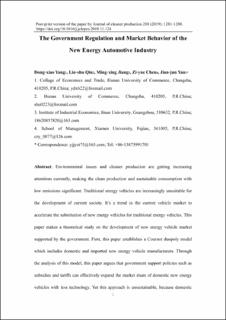| dc.contributor.author | Yang, Dong-xiao | |
| dc.contributor.author | Qiu, Lin-shu | |
| dc.contributor.author | Yan, Jian-jun | |
| dc.contributor.author | Chen, Ziyue | |
| dc.contributor.author | Jiang, Mingxing | |
| dc.date.accessioned | 2020-03-31T08:07:13Z | |
| dc.date.available | 2020-03-31T08:07:13Z | |
| dc.date.created | 2019-05-28T12:14:12Z | |
| dc.date.issued | 2019 | |
| dc.identifier.citation | Journal of Cleaner Production. 2019, 210 1281-1288. | en_US |
| dc.identifier.issn | 0959-6526 | |
| dc.identifier.uri | https://hdl.handle.net/11250/2649569 | |
| dc.description.abstract | Environmental issues and cleaner production are getting increasing attentions currently, making the clean production and sustainable consumption with low emissions significant. Traditional energy vehicles are increasingly unsuitable for the development of current society. It's a trend in the current vehicle market to accelerate the substitution of new energy vehicles for traditional energy vehicles. This paper makes a theoretical study on the development of new energy vehicle market supported by the government. First, this paper establishes a Cournot duopoly model which includes domestic and imported new energy vehicle manufacturers. Through the analysis of this model, this paper argues that government support policies such as subsidies and tariffs can effectively expand the market share of domestic new energy vehicles with less technology. Yet this approach is unsustainable, because domestic new energy vehicles with less technology can only survive in the market by shortening the gap with imported brands. Secondly, this paper establishes a Stackelberg model with product price as the decision variable and find that when there is a technical gap, the first mover advantage in the market will no longer exist. Finally, this paper compares two kinds of subsidies for domestic new energy vehicles and shows that the two subsidies are not different from subsidizing consumers or enterprises in expanding market share, and the consumer can obtain higher social welfare level as the subsidy object. | en_US |
| dc.language.iso | eng | en_US |
| dc.publisher | Elsevier | en_US |
| dc.rights | Attribution-NonCommercial-NoDerivatives 4.0 Internasjonal | * |
| dc.rights.uri | http://creativecommons.org/licenses/by-nc-nd/4.0/deed.no | * |
| dc.title | The government regulation and market behavior of the new energy automotive industry | en_US |
| dc.type | Peer reviewed | en_US |
| dc.type | Journal article | en_US |
| dc.description.version | acceptedVersion | en_US |
| dc.source.pagenumber | 1281-1288 | en_US |
| dc.source.volume | 210 | en_US |
| dc.source.journal | Journal of Cleaner Production | en_US |
| dc.identifier.doi | 10.1016/j.jclepro.2018.11.124 | |
| dc.identifier.cristin | 1700843 | |
| dc.description.localcode | © 2018. This is the authors’ accepted and refereed manuscript to the article. Locked until 13.11.2020 due to copyright restrictions. This manuscript version is made available under the CC-BY-NC-ND 4.0 license http://creativecommons.org/licenses/by-nc-nd/4.0 | en_US |
| cristin.unitcode | 194,64,94,0 | |
| cristin.unitname | Institutt for vareproduksjon og byggteknikk | |
| cristin.ispublished | true | |
| cristin.fulltext | original | |
| cristin.qualitycode | 2 | |

